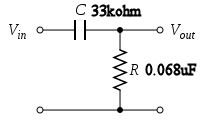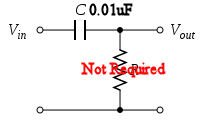After figuring out via another thread on here that I should implement a high-pass filter at 70Hz for my 4" Tang Band speakers, I got my google on to find out how to make one. Going by this site, http://www.daqarta.com/0mfffilt.htm and good old wikipedia I used the formula F=1/(2.Pi.R.C) and an assumed resistor value of 33kohm to get a capacitor value of 0.068uF
I've attached a schematic of it. Will this do the job as a crossover?
Also, I'm wondering about the components I can use for it. I sourced the parts from my local electronics place:
- 33kohm resistor; http://www.jaycar.co.nz/productView.asp?ID=RR2810&keywords=33kohm&form=KEYWORD
- 0.068uF capacitor; http://www.jaycar.co.nz/productView.asp?ID=RM7115&keywords=0.068UF&form=KEYWORD
It's not exactly high-end stuff, should I be looking at something even a little better or will it not matter?
I've attached a schematic of it. Will this do the job as a crossover?
Also, I'm wondering about the components I can use for it. I sourced the parts from my local electronics place:
- 33kohm resistor; http://www.jaycar.co.nz/productView.asp?ID=RR2810&keywords=33kohm&form=KEYWORD
- 0.068uF capacitor; http://www.jaycar.co.nz/productView.asp?ID=RM7115&keywords=0.068UF&form=KEYWORD
It's not exactly high-end stuff, should I be looking at something even a little better or will it not matter?
Attachments
Hi,
the 33k might add a bit of noise to your passive filter.
try lowering the R and raising the C.
10k for R and 220nF for C might be better.
This forms a single pole (-6dB/octave) filter.
It's only 3dB down at 70Hz and about 9dB down at 35Hz.
An active 2pole filter might give nearer what you need, i.e. protection for your driver. Look up Sallen & Key (S&K) and Butterworth and unity gain filter etc. ESP covers this topic pretty well, with over five or six projects and theory.
the 33k might add a bit of noise to your passive filter.
try lowering the R and raising the C.
10k for R and 220nF for C might be better.
This forms a single pole (-6dB/octave) filter.
It's only 3dB down at 70Hz and about 9dB down at 35Hz.
An active 2pole filter might give nearer what you need, i.e. protection for your driver. Look up Sallen & Key (S&K) and Butterworth and unity gain filter etc. ESP covers this topic pretty well, with over five or six projects and theory.
AndrewT said:
This forms a single pole (-6dB/octave) filter.
It's only 3dB down at 70Hz and about 9dB down at 35Hz.
Actually it's down 6 dB at 35Hz.
It depends where we stick that filter what the real impedance ( filter accuracy) will be, mostly the corner frequency will be lower than you think unless you have the schematic of the amps.
AndrewT said:
An active 2pole filter might give nearer what you need, i.e. protection for your driver. Look up Sallen & Key (S&K) and Butterworth and unity gain filter etc.
A steeper filter will work but it won't be much effort to try an accurate single zero filter.
An active filter unless you optimize it very carefully for low noise, could certainly be much more noise than a single shunt carbon resistor. A bigger mine field for the novice certainly.
You could model the effect of the filter by reducing the power in unibox down from half Pmax (-3dB) at 70Hz etc.
The input impedance of your filter is in parallel with the input R of your amplifier (if you ignore it your filter corner will be wrong). You'd be better just to put an in-line cap of an appropriate value where the cap + the input R of your amp is the filter.
Here is a more thorough article on PLLXOs (passive line level XOs).
http://t-linespeakers.org/tech/filters/passiveHLxo.html
dave
Here is a more thorough article on PLLXOs (passive line level XOs).
http://t-linespeakers.org/tech/filters/passiveHLxo.html
dave
@ planet10: I've read up that page you linked to and started to work through the formulas it provides that take into account inputimpedance. One thing though: I have no idea what the input impedance of the Amp6-Basic is...
EDIT: I found something via google that referred to it being 22k... Is this correct?
EDIT: I found something via google that referred to it being 22k... Is this correct?
revans said:@ planet10: I've read up that page you linked to and started to work through the formulas it provides that take into account inputimpedance. One thing though: I have no idea what the input impedance of the Amp6-Basic is...
EDIT: I found something via google that referred to it being 22k... Is this correct?
I don't know. Sounds about right. If you have a schematic it usually be read of that, but i'd email 41 Hz and ask (the spec isn't on their site -- an oversight as it is an important piece of info when deciding if a specific pre-amp will work with it)
dave
Yeah I'll get onto that.
But... if we were to assume for the moment that the input impedance was 22k, then going by the formulas at the link you provided me:
Given a R1 value of 7.5k, the value of the capacitor [C1] will be ~303nF; and the value of the resistor [R2] will be ~11.4k
Does this seem alright?
But... if we were to assume for the moment that the input impedance was 22k, then going by the formulas at the link you provided me:
Given a R1 value of 7.5k, the value of the capacitor [C1] will be ~303nF; and the value of the resistor [R2] will be ~11.4k
Does this seem alright?
Yeah I'll get onto that.
But... if we were to assume for the moment that the input impedance was 22k, then going by the formulas at the link you provided me:
http://t-linespeakers.org/tech/filters/passiveHLxo.html
Given a R1 value of 7.5k, the value of the capacitor [C1] will be ~303nF; and the value of the resistor [R2] will be ~11.4k
Does this seem alright?
But... if we were to assume for the moment that the input impedance was 22k, then going by the formulas at the link you provided me:
http://t-linespeakers.org/tech/filters/passiveHLxo.html
Given a R1 value of 7.5k, the value of the capacitor [C1] will be ~303nF; and the value of the resistor [R2] will be ~11.4k
Does this seem alright?
AndrewT said:Hi,
choose a 330nF or a 270nF capacitor and work back to the two parallel resistors needed to give the frequency you require
A more elegant solution (if you don't mind modding your gear that is)
Rather than adding additional parts you could exchange a lower value cap in the amps existing input DC block. Again the amps schematic and part size is useful. Depending on what you like, an audiophile grade capacitor could be used here,
Even with a single order HP filter like this, you'll be miles ahead of the guy who did nothing.
Note FWIW - This capacitor might be changed again in the course of further upgrades to the system.
infinia, thanks for the suggestion but I'm not confident in modding my Amp6-Basic. I'll just go with hp filter with a 330/270nF cap and whatever value of resistor I get.
Oh by the way, just in case anyone cares, I emailed the guy who I got to put together my Amp6-Basic (yes, I'm not exactly great at soldering) and the stock input impedance is 22k, though apparently he may have put in 47k instead as that improves the amp's performance with mp3 players.
Oh by the way, just in case anyone cares, I emailed the guy who I got to put together my Amp6-Basic (yes, I'm not exactly great at soldering) and the stock input impedance is 22k, though apparently he may have put in 47k instead as that improves the amp's performance with mp3 players.
revans said:infinia, thanks for the suggestion but I'm not confident in modding my Amp6-Basic. I'll just go with hp filter with a 330/270nF cap and whatever value of resistor I get.
Oh by the way, just in case anyone cares, I emailed the guy who I got to put together my Amp6-Basic (yes, I'm not exactly great at soldering) and the stock input impedance is 22k, though apparently he may have put in 47k instead as that improves the amp's performance with mp3 players.
22k = red- red -orange
47K = yellow-violet- orange
revans said:. I'll just go with hp filter with a 330/270nF cap and whatever value of resistor I get.
Oh by the way, just in case anyone cares, I emailed the guy who I got to put together my Amp6-Basic (yes, I'm not exactly great at soldering) and the stock input impedance is 22k, though apparently he may have put in 47k instead as that improves the amp's performance with mp3 players.
Looks like your Amp 6 may already be modified....
If the input R is 22k then C=1/(2*pi*f*R)=1/(6.28*70*22000)=0.00000010335 F ~ 0.1uF
If the input R is 22k then C=0.00000004838 F ~ 0.05 uF
You do not need (and should not use) an additional R in Parallel with the input impedance.
dave
planet10 said:
Looks like your Amp 6 may already be modified....
If the input R is 22k then C=1/(2*pi*f*R)=1/(6.28*70*22000)=0.00000010335 F ~ 0.1uF
If the input R is 22k then C=0.00000004838 F ~ 0.05 uF
You do not need (and should not use) an additional R in Parallel with the input impedance.
dave
planet10 calculated the new amp6 DC block cap value
if otherwise solve C=Cnew*Camp/(Cnew+Camp)
infinia said:planet10 calculated the new amp6 DC block cap value
if otherwise solve C=Cnew*Camp/(Cnew+Camp)
Indeed -- i did make the assumption that there was no DC blocking cap.
dave
- Status
- This old topic is closed. If you want to reopen this topic, contact a moderator using the "Report Post" button.
- Home
- Design & Build
- Parts
- Just to check - Is my high pass filter ok?

